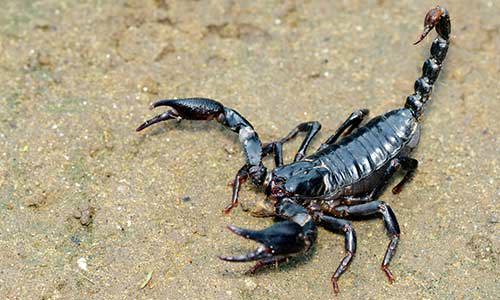Emperor Scorpion
Pandinus imperator

About the Emperor Scorpion

Geographic Range:

Class: Arachnida
Order: Scorpiones
Family: Scorpionidae
Genus: Pandinus
Species: imperator
Emperor scorpions, the largest of their kind, have a striking black appearance with a fluorescent blue-green glow under ultraviolet light. Their bodies feature two frontal pincers, four legs, and a tail ending in a stinger. With poor eyesight, they rely on touch, detecting vibrations through body hairs and pectines. Nocturnal and timid, they prefer to flee over confrontation, using their stingers only when cornered. While their venom is relatively mild, a pinch from their pincers proves more painful to humans.
Committed to Conservation
The illegal pet trade poses the biggest danger to emperor scorpions. They're frequently taken from the wild for the exotic pet market, requiring special permits for importation into the US and beyond.
You can help!
Responsible pet ownership is a great way to protect wildlife. Before bringing home a new pet, ask where the animal came from and if it’s legal to own where you live. Learn more about our work to save animals from illegal trafficking.
About the Emperor Scorpion
Appearance:
Emperor scorpions are the largest of the scorpion species. They have a shiny black appearance, and they emit a fluorescent blue-green glow under ultraviolet light. A scorpion’s body consists of two large frontal pincers, four legs, and a long tail ending in a stinger.
These scorpions have poor eyesight and mainly rely on touch, detecting vibrations using body hairs and pectines. These comb-like structures located behind their limbs are used to gather sensory information. Male scorpions have significantly larger pectines, which are commonly used for discerning a scorpion’s sex.
Size:
Female emperor scorpions typically outsize males. On average, females measure around 20 centimeters in length, whereas males average about 15 centimeters. Pregnant females can weigh approximately 28 grams.
Diet:
The emperor scorpion’s diet mainly includes insects and other arthropods, most commonly termites. They can also occasionally hunt small vertebrates.
Reproduction:
Emperor scorpions are monogamous. In the wild, both females and males reach sexual maturity at four years of age. Elaborate mating rituals occur throughout the year. During these rituals, the male scorpion grasps the female's pedipalps and engages in behaviors such as sexual stinging and cheliceral "kissing" before depositing sperm. Following mating, the female may choose to kill and consume the male.
Females have a nine-month gestation period, after which they’ll give live birth to 10 - 12 young. The internal eggs can grow apoikogenically (with yolk) or katikogenically (without yolk) depending on the mother’s resources. Scorplings are born pearly white and defenseless, heavily relying upon their mother for food and protection. A mother will often carry her young on her back until they’re old enough to be on their own. Should they opt to stay, the mother might occasionally resort to consuming them.
Social Structure:
Emperor scorpions typically live in colonies of up to 15 individuals. When under stress, they can turn to cannibalism, though this behavior is rare.
Behavior:
These scorpions are nocturnal creatures. They tend to be timid, often opting to flee rather than engage in combat, resorting to their stingers only when cornered. Their venom is relatively mild, with a pinch from their pincers known to be more painful for humans than their sting. Emperor scorpions primarily hunt using their pincers rather than their stingers, using their venom to liquefy the insides of their prey for consumption.
They have a unique walk, extending their whole leg (femur- patella joint and patella-tibia joint) simultaneously.
Habitat/Range:
Emperor scorpions are found in hot and humid West African forests, including Nigeria, Togo, Sierra Leone, Ghana, and the Congo. They live communally under leaf litter, forest debris, stream banks and even termite mounds.
Median Life Expectancy:
Unknown in the wild
Conservation Status:
IUCN Red list (Not evaluated), US federal (No special status), CITES Endangered under Appendix 2.
Threats:
The primary threat to the emperor scorpion is the illegal pet trade. This species is often extracted from the wild for sale as exotic pets. Special permits are necessary to import emperor scorpions into the United States and other countries. They can also be collected for their venom, which has been shown to have anti-malarial and anti-bacterial qualities.
Fun Fact:
Emperor scorpions play a crucial role as a keystone species within their ecosystem. By preying upon a diverse range of insect and arthropod species, they contribute to regulating population numbers within their habitat. Also, scorpions themselves serve as prey for various predators, including bats, birds, mammals, and spiders, highlighting their importance in the ecological balance of their habitat.
You Can Find This Animal in the Tropical Forest
Ecosystem guardians
Emperor scorpions play an important role as "keystone species." They help regulate population numbers within their ecosystem by playing the part of both predator and prey!
You might also like
At Franklin Park Zoo:
At Stone Zoo:


